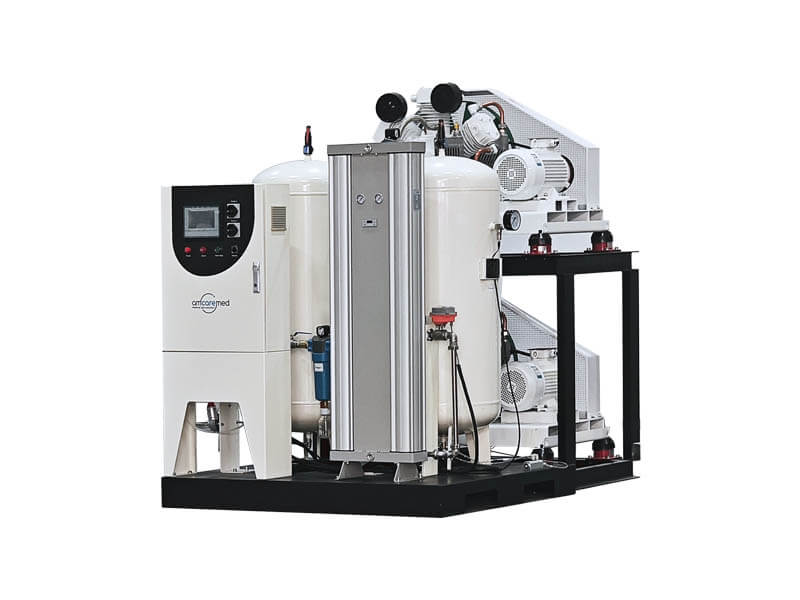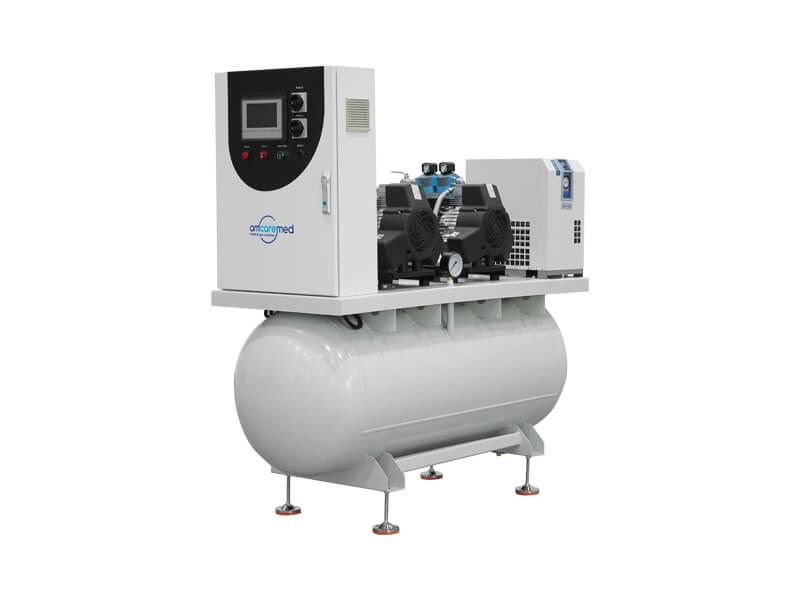Un compresor de aire médico de pistón es una pieza crucial del equipo en los centros de atención médica, Proporcionar limpieza, seco, y aire medicinal presurizado para diversas aplicaciones médicas. A diferencia de los compresores de aire industriales, Los compresores de aire médicos deben cumplir con estrictos estándares de calidad y seguridad para garantizar que el aire suministrado esté libre de contaminantes y sea seguro para el uso del paciente.
Entre los diferentes tipos de compresores de aire medicinal disponibles, el compresor de aire medicinal de pistón es uno de los más utilizados debido a su Alta eficiencia, durabilidad, y confiabilidad en entornos sanitarios. En este artículo se explora la Principios de funcionamiento, Ventajas, Aplicaciones, y mantenimiento de compresores de aire medicinal de pistón.
1. ¿Qué es un compresor de aire médico de pistón??
Un compresor de aire médico de pistón (También conocido como compresor alternativo) Funciona con uno o más pistones para comprimir el aire dentro de un cilindro. Este proceso aumenta la presión del aire, lo que lo hace adecuado para diversas aplicaciones médicas. A diferencia de los compresores de aire estándar, Compresores de pistón de grado médico están diseñados para ofrecer Libre de aceite, Libre de contaminantes, y aire libre de humedad, Garantizar la seguridad del paciente.

2. Componentes clave de un compresor de aire médico de pistón
-
-
Cilindro y pistón: El pistón se mueve hacia arriba y hacia abajo dentro del cilindro para comprimir el aire.
-
Válvulas de admisión y escape: Estos regulan la entrada y salida de aire.
-
Cigüeñal y biela: Convertir el movimiento de rotación en movimiento alternativo.
-
Sistema de filtración de aire: Elimina el polvo, gérmenes, y otros contaminantes.
-
Sistema de enfriamiento: Evita el sobrecalentamiento y garantiza un funcionamiento continuo.
-
Sistema de secado y purificación: Garantiza que el aire medicinal cumpla con los estándares de calidad.
-
Sistema de regulación de presión: Controla la presión del aire suministrado.
-
3. ¿Cómo funciona un compresor de aire médico de pistón??
El principio de funcionamiento de un compresor de aire médico de pistón se basa en Movimiento alternativo:
-
-
Toma de aire: El pistón se mueve hacia abajo, creando un vacío que atrae aire hacia el cilindro.
-
Fase de compresión: El pistón se mueve hacia arriba, comprimiendo el aire y aumentando su presión.
-
Suministro de aire: El aire comprimido es empujado hacia afuera a través de la válvula de escape hacia la tubería de aire medicinal.
-
Filtración y secado: El aire comprimido pasa a través de filtros y un sistema de secado para eliminar la humedad y los contaminantes.
-
Almacenamiento y distribución: El aire purificado se almacena en un tanque o se suministra directamente a los equipos médicos.
-
Este ciclo se repite continuamente, garantizar un suministro constante de limpio, aire medicinal comprimido para aplicaciones hospitalarias.

4. Ventajas de un compresor de aire médico de pistón
4.1 Aire exento de aceite y libre de contaminantes
Las aplicaciones médicas requieren Aire de alta pureza Libre de aceite y otros contaminantes. La mayoría de los compresores de aire medicinal de pistón utilizan Tecnología exenta de aceite, Garantizar la seguridad del paciente y el cumplimiento de las normas médicas.
4.2 Rendimiento fiable y duradero
Los compresores de pistón son conocidos por su durabilidad y puede funcionar durante largas horas sin un desgaste significativo. Con un mantenimiento adecuado, Pueden durar muchos años en entornos hospitalarios.
4.3 Solución rentable
En comparación con otros tipos de compresores de aire medicinal, Los compresores de pistón son más asequibles en términos de costo inicial y mantenimiento. Proporcionan una Alta relación rendimiento-coste para hospital y clínica.
4.4 Alta eficiencia de compresión
Los compresores de pistón pueden lograr Relaciones de compresión más altas que otros tipos de compresores, lo que los hace ideales para aplicaciones que requieren de aire medicinal de alta presión.
4.5 Aplicaciones versátiles
Estos compresores se pueden utilizar en: Una amplia gama de escenarios médicos, incluida la ventilación, Procedimientos quirúrgicos, y anestesia.
5. Aplicaciones de los compresores de aire médicos de pistón
5.1 Soporte respiratorio y ventilación
El aire medicinal es esencial para: Ventiladores, Máquinas CPAP, y concentradores de oxígeno, Garantizar que los pacientes reciban un soporte respiratorio adecuado.
5.2 Administración de anestesia
Uso de máquinas de anestesia aire medicinal comprimido para mezclar y administrar gases anestésicos de forma segura.
5.3 Instrumental quirúrgico y herramientas neumáticas
Muchos instrumentos quirúrgicos y herramientas médicas neumáticas dependen de aire medicinal a presión para un funcionamiento preciso y eficiente.
5.4 Aplicaciones de UCI y Emergencia
Los compresores de aire médico de pistón proporcionan Suministro de aire que salva vidas Para los pacientes en Unidades de cuidados intensivos (Unidades de cuidados intensivos), Cuidados neonatales, y salas de emergencia.
5.5 Equipos de laboratorio y diagnóstico
Cierto Equipos médicos y de diagnóstico requerir limpio, Aire presurizado para un funcionamiento preciso, como analizadores de gases en sangre.
6. Mantenimiento de un compresor de aire médico de pistón
Un mantenimiento adecuado es esencial para garantizar Fiabilidad a largo plazo y Cumplimiento de las normas médicas. Algunas prácticas clave de mantenimiento incluyen::
6.1 Reemplazo regular del filtro
-
La entrada de aire y los filtros bacterianos deben ser reemplazado periódicamente para garantizar Salida de aire limpio.
-
Los filtros sucios pueden: Reducir la eficiencia y contaminar el aire medicinal.
6.2 Lubricación (Si es necesario)
-
La mayoría de los compresores de aire medicinal son Libre de aceite, pero si la unidad requiere lubricación, Debe realizarse utilizando Lubricantes de grado médico para evitar la contaminación.
6.3 Comprobación de fugas y problemas de presión
-
Regular Inspecciones debe llevarse a cabo para Detección de fugas de aire y Inconsistencias de presión.
-
Ningún Tuberías o sellos dañados debe ser reparado de inmediato.
6.4 Limpieza y esterilización
-
Dado que el aire medicinal se utiliza directamente para el cuidado del paciente, El compresor y los tanques de almacenamiento de aire deben estar Limpiado y esterilizado regularmente.
6.5 Monitoreo de Sistemas de Alarma
-
Muchos compresores de aire medicinal modernos vienen con Sistemas de alarma y monitorización que alertan al personal sobre las fluctuaciones de presión, sobrecalentamiento, o necesidades de mantenimiento.
6.6 Cumplimiento de las normas de seguridad
Los hospitales deben asegurarse de que sus compresores de aire medicinal cumplan con Normas internacionales de seguridad y reglamentarias, como:
-
-
ISO 7396-1 (Sistemas de gasoductos medicinales)
-
NFPA 99 (Código de Establecimientos de Atención Médica)
-
ES ISO 13485 (Gestión de calidad para dispositivos médicos)
-
7. Conclusión
Un compresor de aire médico de pistón es un componente esencial de las instalaciones sanitarias modernas, garantizar un suministro fiable de limpio, Aire presurizado para el cuidado del paciente. Con su Tecnología exenta de aceite, Alta eficiencia, y eficacia en función de los costos, Sigue siendo la opción preferida de los hospitales, Clínicas, y unidades de emergencia.
Al mantener un estricto Normas de seguridad, Mantenimiento adecuado, e inspecciones periódicas, Los proveedores de atención médica pueden garantizar que su El compresor de aire médico de pistón funciona al máximo rendimiento, Entrega Aire medicinal seguro e ininterrumpido a los pacientes necesitados.
